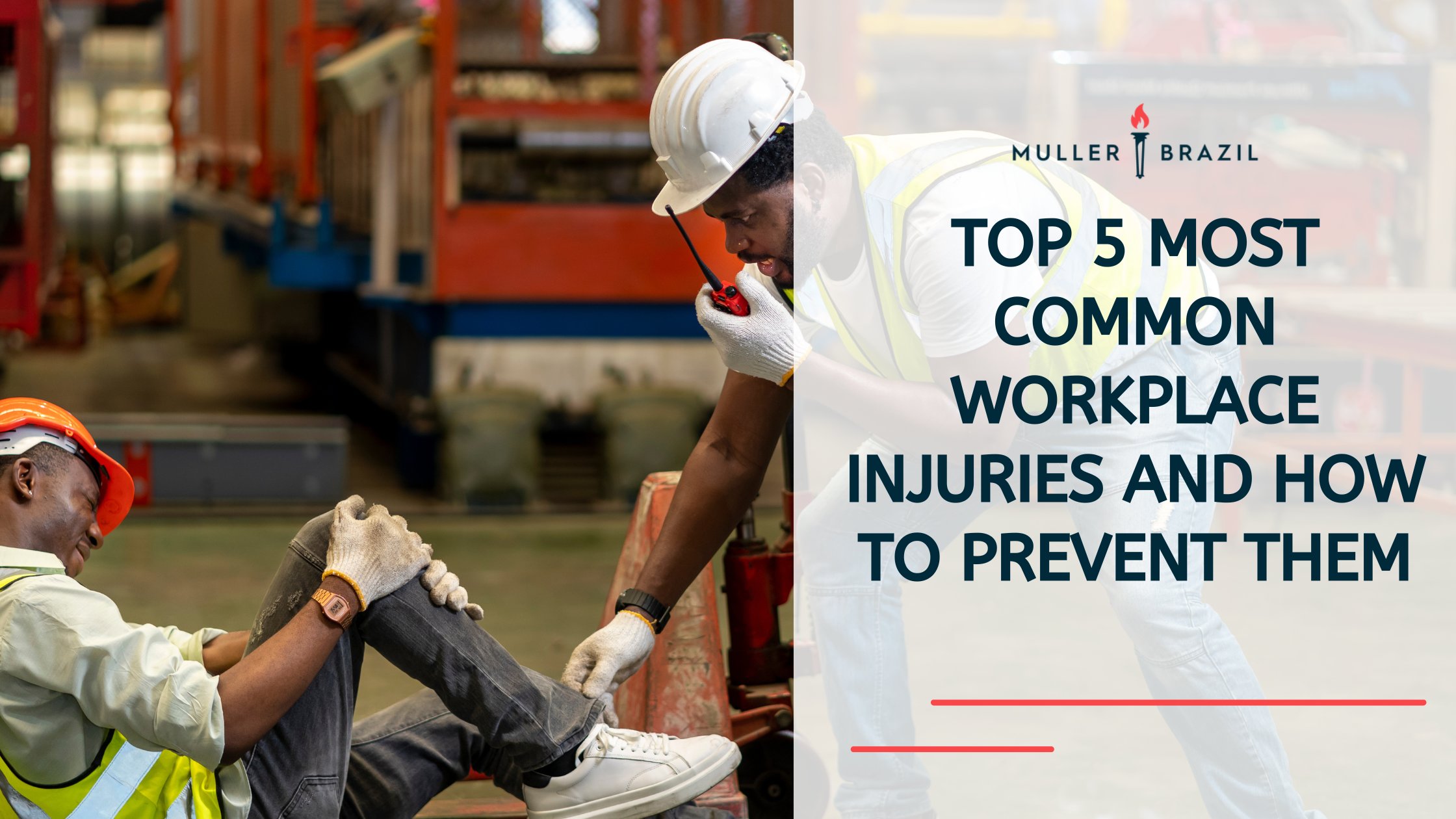5 min read
Top 5 Most Common Workplace Injuries and How to Prevent Them
![]() Maximillian J. Muller, Esquire
Jun 26, 2024 10:18:23 AM
Maximillian J. Muller, Esquire
Jun 26, 2024 10:18:23 AM
Workplace injuries are devastating, both physically and emotionally. If you're reading this, you or someone you care about may have been injured at work, and we want you to know that you're not alone.
Every year, millions of workers in the United States suffer from various types of workplace accidents, leading to pain, financial stress, and uncertainty about the future. At Muller Brazil, we understand the challenges that come with workplace injuries. Our goal is to provide you with information on the most common workplace injuries, their causes, and your rights as an injured worker. Whether it's a minor slip or a major accident, knowing your rights and how to protect yourself is key.
5 Most Common Types of Workplace Injuries
Workplace injuries vary widely depending on the nature of the job and the work environment. Understanding the most common types of injuries and where they are likely to occur will help you take preventive measures. Here are the most frequent workplace injuries:
1. Overexertion and Bodily Reaction
Overexertion injuries result from excessive physical effort, such as lifting, pushing, pulling, holding, or carrying heavy objects. These injuries are especially prevalent in jobs that require manual labor, including construction, manufacturing, and warehousing. According to the National Safety Council (NSC), overexertion and bodily reactions account for 31.7% of all work-related injuries.
- Common Occurrences: Construction, manufacturing, warehousing.
- Prevention: Proper training on lifting techniques and regular breaks.
Specific Injuries:
- Muscle Strains: Often caused by lifting heavy objects without proper technique.
- Back Injuries: Resulting from repetitive movements or heavy lifting.
- Joint Injuries: Such as tendonitis or bursitis, commonly from repetitive tasks.
2. Slips, Trips, and Falls
Slips, trips, and falls are some of the most common and dangerous workplace injuries. These incidents occur when an employee slips on a wet floor, trips over an object, or falls from a height. The NSC reports that falls account for 27.5% of work-related injuries, often leading to severe injuries or fatalities.
- Common Occurrences: Construction sites, retail environments, office settings.
- Prevention: Ensure work areas are clean, well-lit, and free of obstacles.
Specific Injuries:
- Fractures: Particularly common in the wrists, arms, or hips.
- Head Injuries: Including concussions or traumatic brain injuries.
- Sprains and Strains: Especially in the ankles or knees.
3. Contact with Objects and Equipment
Injuries from contact with objects and equipment happen when workers are struck by or caught in machinery, or when objects fall on them. These incidents are common in industries like construction, manufacturing, and warehousing, where heavy machinery and equipment are used daily. Such incidents account for 26% of workplace injuries.
- Common Occurrences: Construction, manufacturing, warehousing.
- Prevention: Regular maintenance of equipment and proper training on machinery use.
Specific Injuries:
- Crushed Limbs: From being caught in or struck by machinery.
- Cuts and Lacerations: Often from sharp tools or equipment.
- Bruises and Contusions: From falling objects or equipment malfunctions.
4. Transportation Incidents
Transportation incidents involve vehicle accidents that occur during work-related travel. These incidents are frequent among delivery drivers, transportation workers, and employees who travel for business purposes. Transportation-related incidents are a leading cause of workplace fatalities.
- Common Occurrences: Delivery drivers, transportation workers, business travel.
- Prevention: Guarantee safe driving practices and regular vehicle maintenance.
Specific Injuries:
- Whiplash: Common in rear-end collisions.
- Fractures: Particularly in the ribs, legs, or arms.
- Internal Injuries: Such as organ damage from severe impacts.
5. Exposure to Harmful Substances or Environments
Exposure to harmful substances or environments includes injuries resulting from contact with hazardous chemicals, extreme temperatures, or loud noises. These exposures are common in manufacturing plants, chemical plants, and construction sites. Such exposure leads to acute injuries or long-term health issues.
- Common Occurrences: Manufacturing plants, chemical plants, construction sites.
- Prevention: Provide appropriate protective equipment and enforce safety protocols.
Specific Injuries:
- Chemical Burns: From handling hazardous chemicals without proper protection.
- Hearing Loss: Due to prolonged exposure to loud machinery.
- Respiratory Problems: From inhaling toxic fumes or dust.
Common Causes of Workplace Injuries
Understanding the common causes of workplace injuries helps both employees and employers take proactive steps to prevent them. Here are some prevalent causes and how they can be reduced:
Inadequate Training
Lack of proper training is a significant contributor to workplace injuries. When employees are not adequately trained, they may not know how to safely perform their tasks or use equipment properly.
- Insufficient training leads to unsafe practices and accidents.
- Employers should implement comprehensive training programs that cover all aspects of job safety and proper equipment use. Regular refresher courses will also help keep safety practices top of mind.
Poor Housekeeping
A cluttered and untidy workspace leads to slips, trips, and falls, which are among the most common workplace injuries.
- Cluttered workspaces increase the risk of accidents.
- Maintaining a clean and organized work environment is crucial. Employers should enforce regular cleaning schedules and encourage employees to keep their areas tidy.
Defective Equipment
Using malfunctioning or improperly maintained equipment can cause serious injuries. This is particularly true in industries that rely heavily on machinery and tools.
- Malfunctioning equipment can lead to accidents and injuries.
- Regular inspections and maintenance of all equipment are essential. Employers should make sure that all machinery meets safety standards and is in good working condition.
Lack of Safety Measures
The absence of safety protocols and protective gear significantly increases the risk of workplace injuries. Safety measures are designed to protect employees from potential hazards.
- Without proper safety measures, the likelihood of accidents increases.
- Employers must implement strict safety regulations and guarantee that all employees use appropriate protective equipment, such as helmets, gloves, and eye protection. Conducting regular safety drills and audits can also help identify and address potential hazards.
Contact Us Now
What Are Your Rights?
If you suffer a workplace injury, it's crucial to understand your rights and the compensation you are entitled to. Here’s what you can claim:
Medical Expenses
In the event of a workplace injury, you have the right to claim compensation for all related medical expenses. This includes emergency room visits, surgeries, medications, physical therapy, and any other treatments necessary for your recovery.
Lost Wages
Workplace injuries lead to time off work, resulting in lost income. You are entitled to claim compensation for both current and future lost earnings. This makes sure that you are not financially disadvantaged while you recover from your injury.
Disability Benefits
If your injury results in a temporary or permanent disability, you may be eligible for disability benefits. These benefits provide financial support if you are unable to return to work or need to work in a reduced capacity.
Pain and Suffering
In addition to physical injuries, workplace accidents cause emotional and psychological distress. You have the right to seek compensation for pain and suffering, which acknowledges the impact of your injury on your quality of life.
Legal Assistance
Consulting with a Worker’s Compensation Lawyer will help you understand your rights, gather necessary documentation, and guarantee you receive fair compensation. Legal experts will also assist with disputes and negotiations with insurance companies.
Conclusion
Workplace injuries are an unfortunate reality for many workers across various industries. Understanding the types of injuries, their common causes, and your rights as an injured worker can help you process the challenges that come with these incidents. Remember, whether you have experienced a minor slip or a major accident, you have the right to seek compensation and support.
At Muller Brazil, we are here to help you through this difficult time. Our experienced team of attorneys specializes in personal injury and worker's compensation cases, guaranteeing you receive the legal assistance you need. We are committed to fighting for your rights and securing the compensation you are looking for. Take a look at our results!
If you have been injured at work, don't hesitate to reach out to us for a free consultation. Visit Muller Brazil to learn more about how we can assist you with your workplace injury claim and provide the support you need to recover and move forward.
Meet the Author
Max Muller - Founding Partner
Maximillian J. Muller is a founding member of Muller Brazil and My Vaccine Lawyer. Mr. Muller is an experienced litigator in both Federal and State Courts in the areas of vaccine injury, unsafe drug and medical device injury, personal injury, mass torts, and bad faith. Mr. Muller prides himself on keeping Muller Brazil on the cutting edge of injury litigation and running a client-focused practice.
Learn more about Max Muller ⇒


